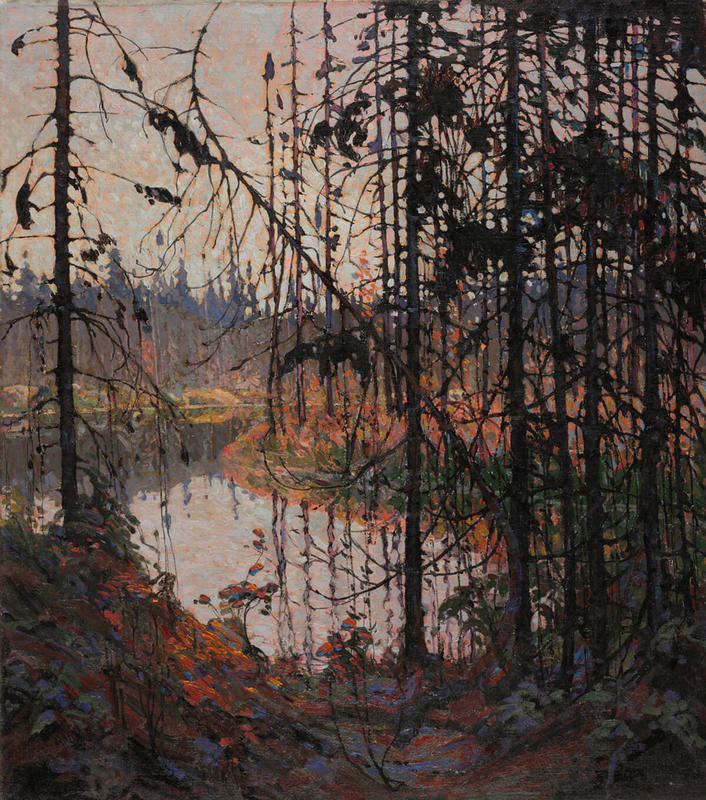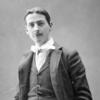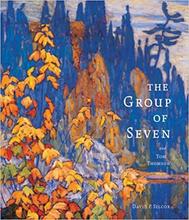More about Northern River
- All
- Info
- Shop

Contributor
Along with The West Wind and The Jack Pine, the gouache and ink Northern River is one of Tom Thomson's most famous works.
Thomson had shared a studio with his friend and fellow painter Alexander Young Jackson until Jackson enlisted in the 60th Battalion of the Canadian army to fight in World War I. The painter was formerly employed by the design firm Grip, but now that the war was going, work was harder for him to find, and he could only afford the twenty-two dollars rent with help from Frank Carmichael, a friend from Grip. According to critics, Thomson, like van Gogh, was chronically plagued by a lack of money, in part because he did not recognize the value of his paintings, evidenced by his self-deprecating comment, in a letter to his patron, James McCallum, that Northern River was his "swamp picture." He would have benefited from a crash course in "self-help," but the industry didn't quite exist yet.
Like van Gogh's, too, Thomson's career was tragically short, adding to his "outsider" status. He was such an outsider that a group of artists, also associated with Grip and McCallum, posthumously inducted him as the first member of their art group, the "Group of Seven." It was his absence, and the brilliance of his works, that solidified the spirit and resolve of the group. As the glam rock band Cinderella sang, you "Don't Know What You Got (Till It's Gone)." As soon as he was no longer around, his career took off, and speculation began as to the cause of his absence and the origins of his works. Thomson's love interest, Winnie Trainor, said that Thomson did not compose Northern River in Ontario's Algonquin Park, which he loved; some critics disagreed, and one author split the difference and said that this work is a composite, "an amalgam of experiences rather than a specific site."
"Where the stories about Thomson become apocryphal is hard to tell," muses one author. We know, however, that Thomson desperately needed the five hundred Canadian dollars that the National Gallery of Canada gave him for this painting, that, perhaps without his blessing, his barren, Friedrich-esque outdoor landscapes have become symbols of the settler's desire to live in a "land without a people," overlooking treaty obligations to the First Peoples, and that, like Theodore Roosevelt, Thomson becomes a sign of the triumph of the individual (white) man in the wilderness. All of these themes stimulate the artistic imagination, as Northern River is the title of a song concluding a popular play about Thomson's life, and a couple hangs a reprint of the painting in their apartment in Phyllis Brett Young's novel The Torontonians.
Sources
- Cooke, John. The influence of painting on five Canadian writers: Alice Munro, Hugh Hood, Timothy Findley, Margaret Atwood, and Michael Ondaatje. Lewiston, NY: Edwin Mellen, 1996.
- Grace, Sherrill. Inventing Tom Thomson: From Biographical Fictions to Fictional Autobiographies and Reproductions. Montreal: McGill-Queen's University Press, 2004.
- Larsen, Wayne. Tom Thomson: Artist of the North. Toronto: Dundurn, 2011.
- Little, John. Who Killed Tom Thomson?: The Truth about the Murder of One of the 20th Century's Most Famous Artists. New York: Simon & Schuster, 2018.
- Murray, Joan. Tom Thomson: Trees. Toronto: McArthur & Co., 1999.
- "Northern River." Art Canada Institute, https://aci-iac.ca/art-books/tom-thomson/key-works/northern-river.
- Reid, Dennis. Tom Thomson. Toronto/Ottawa: Art Gallery of Ontario/National Gallery of Canada, 2002.
Featured Content
Here is what Wikipedia says about Northern River (painting)
Northern River is a 1914–15 oil painting by Canadian painter Tom Thomson. The work was inspired by a sketch completed over the same winter, possibly in Algonquin Park. The completed canvas is large, measuring 115.1 × 102.0 cm (45
5⁄16 × 40
3⁄16 in). Painted over the winter of 1914–15, it was completed in Thomson's shack behind the Studio Building in Toronto. The painting was produced as he was entering the peak of his short art career and is considered one of his most notable works. In 1915 it was purchased by the National Gallery of Canada in Ottawa and has remained in the collection ever since.
Check out the full Wikipedia article about Northern River (painting)













